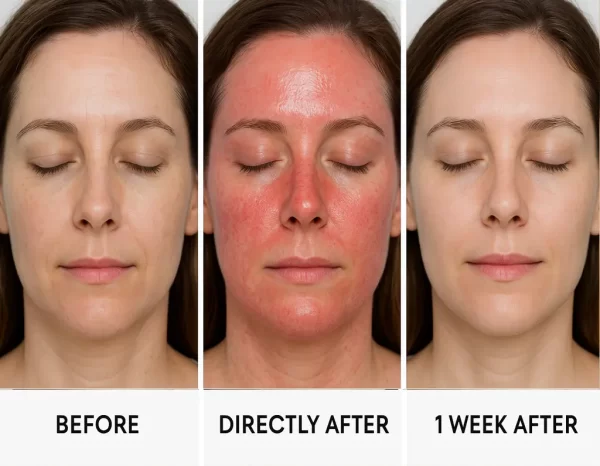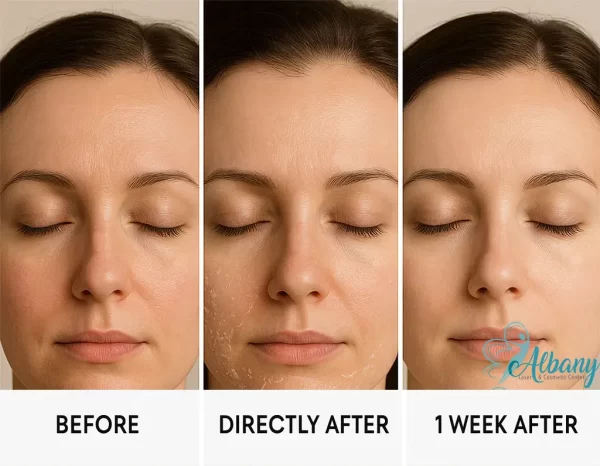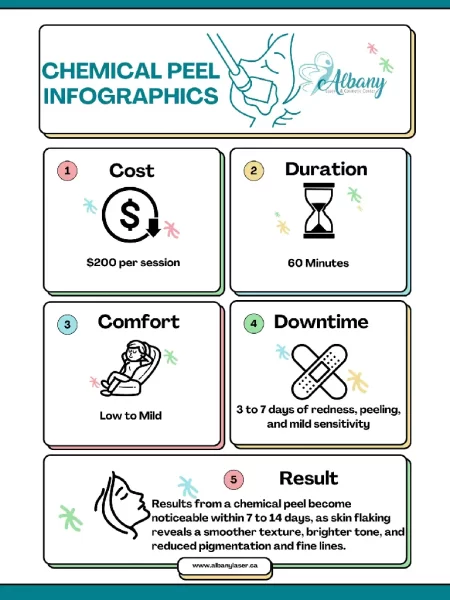Guide to Advanced Chemcial Peels Edmonton
Welcome to Albany Cosmetic and Laser Centre’s comprehensive guide to chemical peels, your ultimate destination for achieving a revitalized and youthful complexion. Our expert team is dedicated to helping you discover the transformative benefits of personalized chemical peel treatments tailored to your unique skin needs.
At Albany Cosmetic and Laser Centre, we understand that every individual’s skin is different. That’s why we offer a range of chemical peel options, each designed to address specific concerns such as acne scars, uneven texture, fine lines, and sun damage. Our advanced chemical peels work by applying a specially formulated solution to exfoliate the top layers of your skin, revealing the fresh, healthy skin underneath. This process not only improves the appearance of your skin but also stimulates collagen production, leading to long-lasting results.
Do you have a question? Chat with Dr. Smart, our friendly AI assistant available 24/7!
What Is a Chemical Peel?


A chemical peel is a skin‑resurfacing treatment that uses an acidic solution to dissolve the bonds between surface skin cells. Once these cells peel away, a fresh layer of skin appears, often with fewer fine lines, improved texture and more even pigmentation. Chemical peels can be tailored to different depths—superficial, medium or deep—depending on the concerns being addressed. Superficial peels gently brighten the complexion, medium peels treat more noticeable discoloration and fine lines, and deep peels address deeper wrinkles and scarring.
How Do Chemical Peels Work?
During a chemical peel, the practitioner cleanses your skin and applies a solution containing acids such as alpha‑hydroxy acid (AHA), glycolic acid, salicylic acid, trichloroacetic acid (TCA) or phenol. These acids break down the top layer of dead skin cells and stimulate a controlled wound‑healing response. Over the next few days, your skin exfoliates and peels, revealing new skin that is smoother and more even in tone. The process also promotes collagen and elastin production, which helps improve firmness over time.
Chemical Peels vs. Other Skin‑Resurfacing Treatments
While microdermabrasion and laser resurfacing also exfoliate the skin, chemical peels can reach varying depths without the thermal energy of lasers. Superficial peels are well suited for mild discoloration and a quick complexion refresh. Medium peels penetrate deeper layers to address wrinkles and acne scars. Deep peels provide dramatic results but require more downtime and careful monitoring. Our providers will help you decide whether a chemical peel or an alternative treatment is best for your goals and skin type.
Quick Summary of Chemical Peel
Cost And Pricing
Procedure Duration
Treatment benefits
Expected Results
Side Effects And Downtime
Discomfort and Pain Level

What Can Chemical Peels Treat?
Chemical peels address a range of skin concerns, including fine lines, mild to moderate wrinkles, uneven skin tone, hyperpigmentation, sun damage, acne, and certain types of acne scars. They can also help reduce the appearance of melasma, dark spots from hormonal changes, and rough or dull skin texture. While peels improve many conditions, they cannot tighten loose skin or erase very deep scars; in those cases, other treatments may be recommended.
The Chemical Peel Procedure at Albany Cosmetic & Laser Centre
Your journey begins with a consultation to evaluate your skin and discuss your goals. On the day of treatment, we thoroughly cleanse your skin and may apply a pre‑peel solution to ensure even absorption. We protect your eyes and lips, then apply the chosen chemical solution. Throughout the process, we monitor your skin’s response and adjust the peel time if needed. After neutralizing or removing the solution, we apply soothing creams and sunscreen. You’ll leave with detailed aftercare instructions.
Chemical Peel Before & After Results
Before and after images show how chemical peels can reduce discoloration, refine pores and smooth fine lines. Immediately following treatment, your skin may appear red or frosted, and peeling usually begins within a day or two. As the peeling subsides, the underlying skin looks brighter, clearer and more even.
Aftercare Tips
Proper aftercare is crucial for a smooth recovery and optimal results. Avoid picking or pulling flaking skin—let it shed naturally. Keep your skin moisturized and use gentle, non‑irritating products. Stay out of the sun and wear broad‑spectrum sunscreen, as treated skin is more vulnerable to UV damage. Refrain from strenuous exercise, saunas and hot baths for a few days to prevent excess heat. Avoid other exfoliating treatments or hair removal methods on the treated area until your provider clears you to resume them.
Why Choose Albany Cosmetic & Laser Centre?
We pride ourselves on delivering safe, customized chemical peel treatments in a professional setting. Our experienced skincare specialists assess your skin’s needs and choose the appropriate peel strength to achieve your goals with minimal risk. We use high‑quality, medical‑grade solutions and provide comprehensive aftercare support. At Albany Cosmetic & Laser Centre, you’ll receive personalized service, natural‑looking results and a commitment to your skin’s health.
Types of Chemical Peel At Albany Cosmetic and Laser Centre
Chemical peels come in three main types: superficial, medium, and deep.
- Superficial Peels: These use mild acids like alpha-hydroxy acid to gently exfoliate the outer layer of skin, improving minor skin discoloration and rough texture.
- Medium Peels: Utilizing stronger acids such as glycolic or trichloroacetic acid, these peels penetrate the middle layers of skin to remove damaged cells, effectively treating age spots, fine lines, and wrinkles.
- Deep Peels: Using potent acids like phenol, deep peels reach the lower dermal layer, addressing more severe skin issues such as deep wrinkles, scars, and precancerous growths, but requiring longer recovery periods.
Each type of peel is tailored to address specific skin concerns, offering varying levels of exfoliation and rejuvenation.
Frequently Asked Questions
What is a chemical peel?
How do chemical peels work?
Are Chemical exfoliation Treatments painful?
What conditions can chemical peels treat?
How often should I get a chemical peel?
What is the recovery after a chemical peel?
What are the side effects of a chemical peel?
Who should NOT get a chemical Peel ?
What are the different types of chemical peels?
- Light peels (superficial): These target the epidermis to improve skin tone and texture. Examples include glycolic acid peels and salicylic acid peels.
- Medium peels: Penetrating deeper into the dermis, they address pigmentation, wrinkles, and acne scars. A common example is the trichloroacetic acid (TCA) peel.
- Deep peels: These deeply exfoliate to treat significant skin damage, deep wrinkles, and extensive sun damage. Phenol peels are an example of deep chemical peels.
